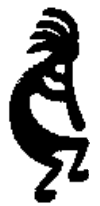Kokopelli
|
|
Kokopelli is a fertility deity, usually depicted as a humpbacked flute player (often with a huge phallus and antenna-like protrusions on his head), who is worshipped by many Native American tribes in the Southwestern United States. Like most fertility deities, Kokopelli presides over both childbirth and agriculture. He is also a trickster god.
Because of his influence over human sexuality, Kokopelli is often depicted with an inhumanly large phallus. Among the Ho-Chunk, this penis is detachable, and he sometimes leaves it in a river in order to have sex with girls who bathe there. Among the Hopi, Kokopelli carries unborn children on his back and distributes them to women (for this reason, young girls are often deathly afraid of him). He often takes part in rituals relating to marriage, and Kokopelli himself is sometimes depicted with a consort, a woman called Kokopelli-mana by the Hohokam and Hopi.
Kokopelli also presides over the reproduction of game animals, and for this reason, he is often depicted with animal companions such as rams and deer. Other common creatures associated with him include sun-bathing animals such as snakes, or water-loving animals like lizards and insects. Because of this, some scholars believe that Kokopelli's flute is actually a blowgun (or started out as one), but this is a minority opinion.
In his domain over agriculture, Kokopelli's fluteplaying chases away the Winter and brings about Spring. Many tribes, such as the Zuni, also associate Kokopelli with the rains. He frequently appears with Paiyatamu, another flautist, in depictions of maize-grinding ceremonies. Some tribes say he carries seeds and babies on his back.
| Contents |
Origins and development
Phallic_kokopelli.png
image:Phallic_kokopelli.png
Kokopelli has been worshipped since at least the time of the Ancient Pueblo Peoples. The first known images of him appear on Hohokam pottery dated to sometime between AD 750 and AD 850.
Kokopelli may have originally been a representation of ancient Aztec traders, known as pochtechas, who traveled to the Southwest from Mexico. Such traders brought their goods in sacks slung across their backs, and this sack may have evolved into Kokopelli's familiar hump (in fact, many tribes make Kokopelli a trader in this way). These men also used flutes to announce themselves as friendly as they approached a settlement. This origin is still in doubt, however, since the first known images of Kokopelli predate the major era of Aztek-Anasazi trade by several hundred years.
Another theory is that Kokopelli is actually an anthropomorphic insect. Many of the earliest depictions of Kokopelli make him very insect-like in appearance. The name "Kokopelli" may be a combination of "Koko", another Hopi and Zuni deity, and "pelli", the Hopi and Zuni word for the desert robber fly, an insect with a prominent proboscis and a rounded back, which is also noted for its zealous sexual proclivities. A more recent etymology is that Kokopelli means literally "kachina hump". Because the Hopi were the tribe from whom the Spanish explorers first learned of the god, their name is the one most commonly used.
Kokopelli is one of the most easily recognized figures found in the petroglyphs and pictographs of the Southwest. The earliest known petroglyph of the figure dates to about A.D. 1000. Kokopelli was one of several kachina dolls sold to tourists. The Spanish missionaries in the area convinced the Hopi craftsmen to omit the phallus from their representations of the figure. As with most kachina dolls, the Hopi Kokopelli was often represented by a human dancer. These dancers apparently had great fun with missionaries and tourists by making obscene and sexual gestures that the foreigners did not understand.
In recent years, the emasculated version of Kokopelli has been adopted as a broader symbol of the Southwestern United States as a whole. His image adorns countless tourist items such as T-shirts, ball caps, and keychains. A bicycle trail between Grand Junction, Colorado and Moab, Utah is now known as the Kokopelli Trail.
Kokopelli bears a passing resemblance to Bradshaw Paintings of North-West Australia (examples (http://www.bradshawfoundation.com/bradshaws/gallery.html)), which could be mere coincidence or sign of a common origin; some have suggested that ancient astronaut theories in the model of Erich von Däniken have attributed both to a common celestial source.
Photographs
Kokopelli2.jpg
Kokopelli3.jpg
Other names
Kokopelli_Lyden_NM.jpg
- Kokopele
- Kokopelli-mana or Kokopelmana (actually, Kokopelli's wife) (Hohokam)
- Kokopeltiyo
- Kokopilau
- Neopkwai'i (Pueblo)
- Ololowishkya (Zuni)
Trivia
In Port Angeles, Washington, there is an upscale Mexican restaurant called Kokopelli's Grill.ca:Kokopelli es:Kokopelli ru:Кокопелли

